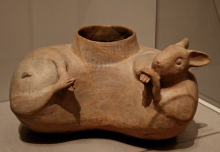tochtli (Mdz8r)
This element for rabbit [tochtli has been carved from the compound sign for the place name, Cuauhtochco. The rabbit appears in profile, standing on its hind legs, with its front legs in the air. Its ears are standing up, and we see one of its eyes is open. Some fangs protrude from its mouth. Its coat is textured and colored purple, with the exception of its underside, which is white.
Stephanie Wood
The rabbit is a prevalent animal in the countryside. It is also a calendrical symbol, for both day and year signs. The shape visible in the moon is also a rabbit, and rabbits had an association with the alcoholic beverage (octli) made from the agave.
Stephanie Wood
c. 1541, but by 1553 at the latest
Stephanie Wood
rabbits, hares, xiuhpohualli, año, turquesa, xihuitl
tochtli. The tochtli (rabbit) was associated with the intoxicating beverage octli (pulque), which was consumed in religious ceremonies and offered to divinities such as Ometochtli. This pot was probably used for this purpose. Photograph by Robert Haskett, Los Angeles County Museum of Art, December 2011.

toch(tli), rabbit, https://nahuatl.wired-humanities.org/content/tochtli
el conejo
Stephanie Wood
Codex Mendoza, folio 8 recto, https://digital.bodleian.ox.ac.uk/objects/2fea788e-2aa2-4f08-b6d9-648c00..., image 25, of 188.
The Bodleian Libraries, University of Oxford, hold the original manuscript, the MS. Arch. Selden. A. 1. This image is published here under the UK Creative Commons, “Attribution-NonCommercial-ShareAlike 3.0 License” (CC-BY-NC-SA 3.0).






